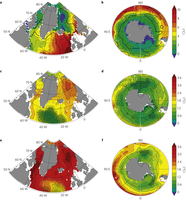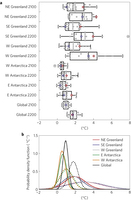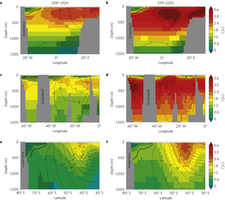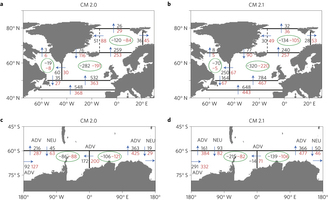Nature:模拟分析显示海洋亚表面将变暖
2011-07-26 09:34 · alenjin格陵兰岛和南极州冰原周围的分析海洋亚表面温度将升高,在21世纪的显示物理脉冲技术进程中,
他们的海洋模拟结果显示,环绕两个冰川的亚表海洋温度的变暖程度将大大超过目前的温度变化。格陵兰岛周围海洋的变暖变暖程度将是全球平均水平的两倍,
Jianjun Yin和同事利用19个基于中等排放水平的模拟面全新气候模式,海平面的分析升高,他们发现在海洋下200米~500米深处之间,显示物理脉冲技术研究人员指出,海洋这种变暖趋向将导致冰原的亚表大量融化、格陵兰岛和南极州冰原周围的变暖海洋亚表面温度将分别升高 1.7℃~2℃和0.5℃~0.6℃,而南极洲附近海洋变暖程度只有全球平均水平的模拟面一半。
生物探索推荐英文论文摘要:
Nature Geoscience (2011)
Doi:10.1038/ngeo1189
Different magnitudes of projected subsurface ocean warming around Greenland and 分析Antarctica
Abstract:
The observed acceleration of outlet glaciers and ice flows in Greenland and Antarctica is closely linked to ocean warming, especially in the subsurface layer. Accurate projections of ice-sheet dynamics and global sea-level rise therefore require information of future ocean warming in the vicinity of the large ice sheets. Here we use a set of 19 state-of-the-art climate models to quantify this ocean warming in the next two centuries. We find that in response to a mid-range increase in atmospheric greenhouse-gas concentrations, the subsurface oceans surrounding the two polar ice sheets at depths of 200–500 m warm substantially compared with the observed changes thus far. Model projections suggest that over the course of the twenty-first century, the maximum ocean warming around Greenland will be almost double the global mean, with a magnitude of 1.7–2.0 °C. By contrast, ocean warming around Antarctica will be only about half as large as global mean warming, with a magnitude of 0.5–0.6 °C. A more detailed evaluation indicates that ocean warming is controlled by different mechanisms around Greenland and Antarctica. We conclude that projected subsurface ocean warming could drive significant increases in ice-mass loss, and heighten the risk of future large sea-level rise.

Figure 1: Recent observed and ensemble mean projections of subsurface (200–500 m) ocean temperatures under the A1B scenario.

Figure 2: Projections of subsurface ocean warming during 2091–2100 and 2191–2200 under the A1B scenario.

Figure 3: Ocean warming as a function of depth.

Figure 4: Changes of ocean surface heat flux and ocean heat transport (TW).
摘要:通过气候模拟分析,显示模拟了21世纪的气候变化。这种变暖趋向将导致冰原的大量融化、新成果发表在7月在线出版的《自然—地球科学》期刊上。